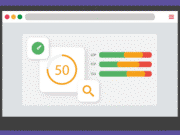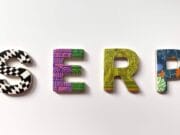Here is a complete SEO Glossary for you. Please review the following 101 Terms related to SEO and Marketing:
1. AdSense:
A system run by Google that posts adverts on the Google search engine and other people’s websites.
2. AdWords:
The system with which advertisers enter their adverts onto the Google Adsense system.
3. AdCopy:
The content that makes up your adverts.
4. Affiliate Marketing:
Advertising by having adverts on other people’s websites, social media sites and search engines.
5. Analytic:
Measurement methods that produce data. The data itself may be called an analytic.
6. Anchor Text:
The text that goes into a hyperlink. The text may be clicked on in order to take the person from one page to another.
7. Black Hat SEO:
SEO (Search Engine Optimization) designed and/or orchestrated to fool or manipulate the search engines.
8. Bookmarks:
Links to websites that are saved, usually in a browser, to make websites easier to find later.
9. Bot:
A program that performs a specific task. For example, Google has spider bots that read web content.
10. Broken Link:
A link that no longer directs a person from one page to another.
11. Browser:
A piece of software that interprets web pages and displays them as per current Internet standards.
12. Canonization:
Picking the correct URL when there are several choices available.
13. Cloaking:
Hiding the content of a page from the viewers, from the search engines, or from standards browsers.
14. Conversion:
Having a viewer complete a certain task as set out by the webmaster.
15. Cost per Action:
CPA allows people with adverts on their website to be paid if a certain conversion action is achieved.
16. Cost Per Impression:
CPC allows people to be paid for having adverts depending on how many people see the adverts.
17. Cost per Click:
With CPC people that have adverts on their websites may be paid every time somebody clicks on their adverts.
18. Click through Rate:
CTR how many people click on the advert after seeing it. It is usually expressed as a percentage.
19. Co-citation:
Used to show search engines that you are quoting and not duplicating/plagiarizing.
20. Contextual Advertising:
Adverts based on the content of a web page and/or even on the cookies a device/PC has.
21. Cross Linking:
Links between websites that are owned by the same company and/or person.
22. Duplicate Content:
The same content being present on more than one domain.
23. Domain:
The address of a website and the name of the website.
24. Dynamic Content:
Content that changes depending on the user, the user’s device, the user’s actions, and cookies.
25. Dynamic Website:
A database-driven website that offers a different website experience to different people.
26. ECommerce Site:
A website that was set up to sell services or products.
27. Error page:
Usually, they display warnings or advice. They are generated when errors have occurred.
28. External Link:
A backlink that points from another domain to your website.
29. Favicon:
A small image that is displayed in the address bar so that people know what your website is when there are multiple tabs open.
30. Gateway page:
Web pages that were optimized simply to draw in traffic to either have them click on adverts or to send the traffic to another website or location.
31. Geo-Targeting:
Advertising or optimizing to appeal to people in a certain geographical area.
32. Hallway Page:
Indexes a few pages that you want Google to find.
33. Headings:
Describes the content of one or more paragraphs in an easy-to-understand manner.
34. Hidden Text:
Text that humans cannot read, but that the search engine bots can read.
35. Hijacking:
Coding that convinces search engines and people that a website is in a certain domain or URL.
36. Hits:
Usually, refers to the number of visitors or number of clicks.
37. Home Page:
The first page on a website that resides on the naked domain.
38. HTML:
Hyper Text Markup Language, which is a scripting language.
39. HTTP:
HyperText Transfer Protocol is used to transfer data.
40. HTTPS:
Using a Secure Socket Layer (SSL) to transfer data to and from the servers and browsers.
41. Hypertext Link:
A link that takes you from one part of a page to another.
42. Inbound Link:
The same as a backlink, where another domain links to yours.
43. Indexed Pages:
Pages that have been read, interpreted, and placed into the Google database.
44. Inlink:
This is another name for inbound links and backlinks. Some people also consider inlinks to be links from one page to another page within the same website.
45. Internal Link:
Links that point internally from one website page to another on the same domain.
46. Impression:
A single impression means that one person has seen the website, advert, or thing in focus.
47. Java Applet:
An applet that is written in Java code.
48. JavaScript:
A client-side scripting language that is commonly used within websites.
49. Keyword Density:
The number of times a keyword appears in web content.
50. Keyword prominence:
How important a certain keyword is when compared with other keywords.
51. Keyword Research:
Research into the most suitable keywords for a website or advert.
52. Keyword Research Tools:
Tools that may help a keyword researcher judge which words are the best to focus on.
53. Keyword Stuffing:
Purposefully entering a keyword too many times into text in order to fool the search engines.
54. Keyword Targeting:
Adverts and websites are optimized for certain keywords, and those keywords may be called target keywords.
55. Keyword density:
How often a target keyword appears in a web page when compared with all the words on the web page.
56. Landing Page:
The page that the user lands on if he or she clicks a link.
57. Link Removal:
Removing links from a search engine’s index.
58. Link Reputation:
Measuring if a link will have a positive or negative effect on your website.
59. Linking Profile:
All of the links that point to your website and what they may mean.
60. Long Tail Keyword:
Keyword phrases that are longer than three words.
61. Meta Description:
Metadata that may appear on the search engine results page.
62. Meta Keywords:
Metadata that tells the search engines which of your words are keywords.
63. Metrics:
A chunk of data that is used to measure something on or about your website.
64. Microblogging:
Small blog posts of just a few words. The most popular form is via the social media site Twitter.
65. Mirror Site:
An exact replica of a single website.
66. Naked Links:
Links that do not have anchor text, images, or any type of media.
67. Navigation:
The name for the system and method by which users get around and navigate your website.
68. Negative Keyword:
Keywords that advertiser do not want to be included in their keyword profile.
69. Niche:
A topic, theme, area, group or “thing” that is set apart from the mainstream in such a way that it has its own identity.
70. Nofollow:
A tag that instructs the search engines not to index a link.
71. Organic Link:
A backlink to another website in a website post.
72. Organic SEO:
Allowing your content to rank up on its own.
73. Outbound links:
Links on your website that go out and over to another website.
74. Page rank:
A now outdated way of judging the search engine friendliness of a website.
75. Page Title:
The title of a web page.
76. Page Views:
A number showing how many people have looked at a web page.
77. Paid links:
A link pointing to another website. The link costs money.
78. Penalty:
A Google penalization–usually for attempts to manipulate its search engine.
79. PPC (Pay per Click):
Promoters pay every time their advert is clicked.
80. Reciprocal Links:
Where one website links to another, and the other website links back.
81. Redirect:
A person lands on a website and is sent to another website.
82. Referrer String:
It’s a header field that identifies another website’s address that is linked to the resource requested.
83. Robots.txt:
It gives instructions to the search engine crawlers to help them crawl the website as the webmaster desires.
84. RSS:
Really Simple Syndication updates users when new content is produced.
85. Search Engine Marketing:
Using search engines to spread a marketing message.
86. Search Engine Optimization:
Abiding by Google search engine guidelines in order to rank higher on all search engines.
87. Search Engine Results Page (SERP):
A list of results after a person enters a query into a search engine.
88. SEO Copywriting:
Content is written for search engines that is also user-friendly.
89. Site Map:
A guide that tells users and/or search engines where the website’s pages are located.
90. Spam:
Automated messages and content that has no thought or consideration behind its dissemination or inclusion.
91. SSL:
Secure Socket Layer is an encryption technology.
92. Static Website:
A website that doesn’t change. The opposite of a dynamic website.
93. Time-On-Page:
How much time a user spends on a web page.
94. TLD:
Top Level Domain.
95. Trackback:
A system that notifies a webmaster when another website has linked to their website.
96. Traffic:
How many visitors a website or web page gets.
97. Unique Visitor:
New traffic that is not repeated traffic from people that have visited before.
98. URL:
Uniform Resource Locator.
99. Viral Marketing:
Marketing that uses other people’s inclination for sharing to spread quickly.
100. Web Crawler:
A program that searches for, searches through, and reads content. It is usually used to index information.
101. White Hat SEO:
Search Engine Optimization that follows the Google guidelines.
This article is written by Stacey Marone. She is a part-time essay writer for https://essays.scholaradvisor.com/. Since graduation, she has become a professional essayist, blogger, and online guest poster. She is able to turn her hand to many things, and is especially knowledgeable about economics, statistics, and search engine marketing.





